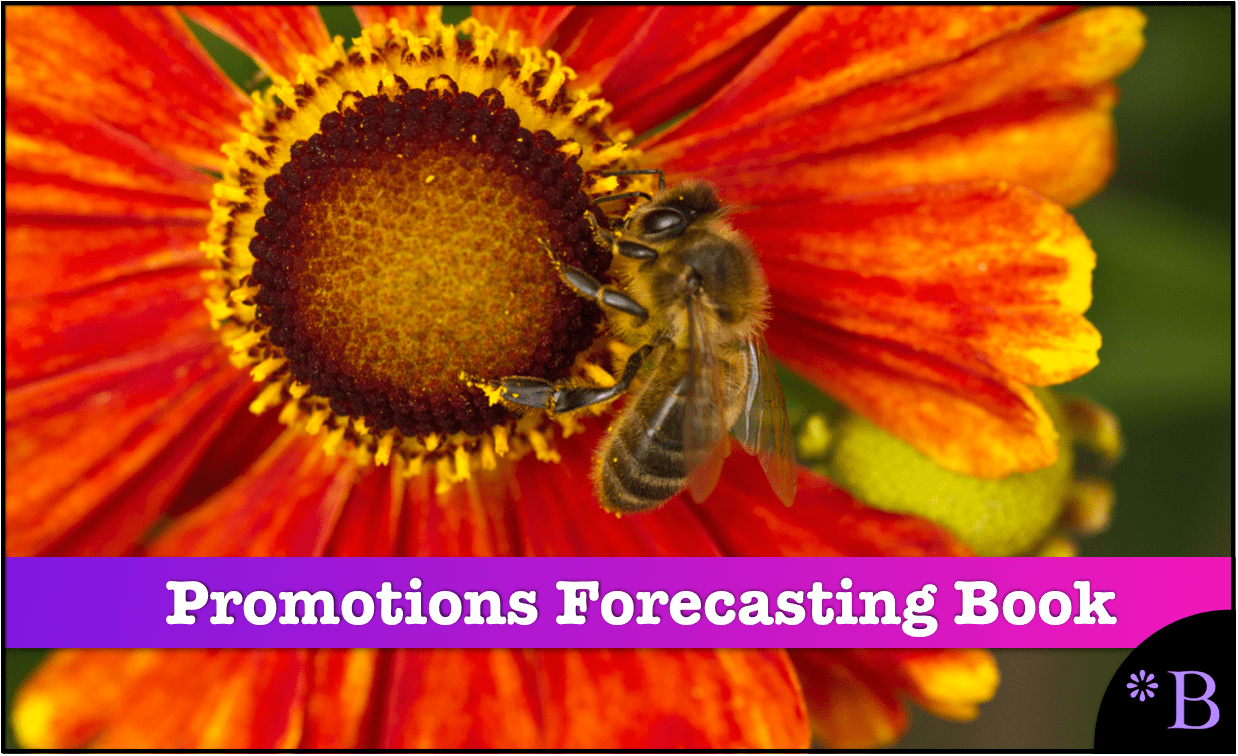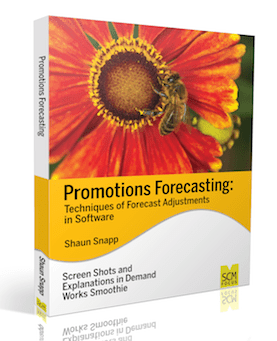
Promotions Forecasting
Screenshots and examples from ToolsGroup, Demand Works, Consensus Point, Right90, and Inkling Markets.
What The Book Covers
Generally, promotional forecasting is not a significant focus of forecasting books, forecasting classes, or statistical forecasting. However, promotions can be an incredibly powerful influence on the demand and a significant factor in reducing forecast accuracy when unaccounted for in the demand history. Promotions degrade forecast accuracy by increasing the variability of the sales history, creating unexpected spikes in demand, and increasing the work on the part of the demand planner, as well as on the part of many other individuals throughout the supply chain.
Buy Now
A Book Based in Reality, Emphasizing Actionable Knowledge
The book provides many examples from real-life project experiences, the emphasis being on the reality of supply chain forecasting projects. While the majority of forecasting books spend a lot of time covering forecasting methods that companies will very rarely (if ever) use, this book adjusts the content to cover topics that can be implemented by companies.
Interconnected to Web Information
In order the keep the book at a manageable and easily readable length, the book also provides numerous links out to the Brightwork Research & Analysis site, where supporting articles allow readers to get into more detail on topics that interest them.
Case Studies
The book also contains case studies of how various forecasting techniques were used on different projects.
Chapters
- Chapter 1: Introduction
- Chapter 2 Where Demand Planning Fits within the Supply Chain Planning Footprint
- Chapter 3: Statistical Forecasting Explained
- Chapter 4: Why Attribute-Based Forecasting is the Future of Statistical Forecasting
- Chapter 5: The Statistical Forecasting Data Layer
- Chapter 6: Removing Demand History and Outliers
- Chapter 7: Consensus Based Forecasting Explained
- Chapter 8: Collaborative Forecasting Explained
- Chapter 9: Bias Removal
- Chapter 10: Effective Forecast Error Management
- Chapter 11: Lifecycle Planning
- Chapter 12: Forecastable Versus Unforecastable Products
- Chapter 13: Why Companies Select The Wrong Demand Planning Software
- Chapter 14: Conclusion
Table of Contents
Chapter 1: Introduction
- Forecast Accuracy and Demand Shaping
- Books and Other Publications on Promotions Forecasting
- The Use of ScreenShots in the Book
- Timing Field Definitions Identification
- How Writing Bias Is Controlled at Brightwork Research & Analysis and Brightwork Research & Analysis Press
- The Approach to the Book
- Important Terminology
- General Terms
- Forecasting Terms
- Marketing Terms
- Application Terms
- Forecasting Application Fields/Terms
- The Brightwork Research & Analysis Site
- Intended Audience
- Abbreviations
- Corrections
Chapter 2 Promotions From Sales/Marketing’s Perspective
- The Evidence for the Benefit of Promotions
- The Lack of Quantification with Respect to Planning Promotions
- The Power Struggle Between Sales and Marketing Over Promotions
- Comparing Promotions Versus the “Everyday Low Price” Strategy
- Why Sales/Marketing Want to Account for the Costs of Promotions
- The Incomplete Nature of Promotion Benefits Accounting
- Conclusion
Chapter 3: Promotions from Supply Chain’s Perspective
Chapter 4: Common Issues with Promotion Forecasting
- Is Extra Complexity Managed with Systems?
- Product Proliferation
- Going Against the Grain
- Conclusion
Chapter 5: Forecastable Versus Unforecastable Products
Chapter 6: Accounting for Previous Promotions in Sales History
- The Software for Managing Promotions
- Porting the Promotional Changes to the Live System
- Sophisticated Promotions Management for Forecasting
- The Promotion Adjustment Calculator
- The Application of Promotion Forecast Adjustments
- Aggregated Promotional Adjustments
- Following Period Promotional Adjustment
- Promotions and Fake Seasonality
- Unaccounted for Promotional Sales and Best-fit Forecasting
- Finding and Accounting for Promotions in the Sales History
- Step 1 – Determine the Outlier Threshold
- Step 2 – Set Up Outlier Threshold in the System
- Step 3 – Filter Outliers to Obtain the PLCs to be Evaluated
- Step 4 – Meet with Sales/Marketing to Receive Input on Promotions
- Step 5 – Build the PAC Through the Process of Working with Sales/Marketing
- Step 6 – Update Forecasting System with the Adjusted History
- Show Promotional Adjustment from Cannibalization
- Conclusion
Chapter 7: Adding Promotions to the Forecast
- Background
- Lifecycle Planning in SAP DP
- Lifecycle Planning in ToolsGroup
- Lifecycle Planning in JDA Demand Management
- Copying Demand History Between Like Products
- Lifecycle Planning (and Other Adjustments) in Demand Works Smoothie
- Method 1: Copy Paste Spreadsheet Functionality in Smoothie for Lifecycle Planning
- Method 2: Setting Life Cycle as an Attribute
- Conclusion
Chapter 8: Communicating with Sales and Marketing and the Promotion Adjustment Calculator
- How Are Sales and Marketing Inputs Managed?
- Step 1: Obtain Sales/Marketing Information on Promotions
- Step 2: Build/Use the Promotion Adjustment Calculator
- Step 3: Make the Adjustments within the Forecasting System
Chapter 9: Conclusion

Buy Now
Questions about the Book?
Do you have any questions about the book? If so, please leave us a comment in the message box to the right, and we will address them.